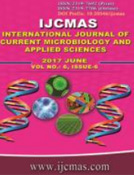


 National Academy of Agricultural Sciences (NAAS)
National Academy of Agricultural Sciences (NAAS)

|
PRINT ISSN : 2319-7692
Online ISSN : 2319-7706 Issues : 12 per year Publisher : Excellent Publishers Email : editorijcmas@gmail.com / submit@ijcmas.com Editor-in-chief: Dr.M.Prakash Index Copernicus ICV 2018: 95.39 NAAS RATING 2020: 5.38 |
Enterococci are the most common aerobic and facultative anaerobic, gram positive cocci. They constitute a part of the normal intestinal flora. However they also occupy other sites such as oral cavity, GUT, skin etc. Enterococci, which earlier considered as low grade pathogens, has now emerged as one of the most important nosocomial pathogens worldwide and are associated with high mortality. Enterococci sp have been emerged as one of the most important cause of nosocomial infections. The main sites of colonization in the hospitalized patients are soft tissue wounds, ulcers and GIT. Enterococcus species of group D streptococcus mainly associated with urinary tract infection and pelvic infection and intra abdomen sepsis and wound infection and produce septicaemia and endocarditis. In contrast to other streptococcus, Enterococcus produces intrinsically resistance to many of antibiotics like cephalosporins and low concentration penicillin. The samples are collected from the outpatients and inpatients of Govt. Mohan Kumaramangalam Medical College Hospital. The isolated Enterococci are then tested for routine antibiotic sensitivity over Mueller Hinton agar in a lawn culture by Kirby Bauer Disc diffusion technique. The diffusion discs loaded with antibiotics - high level gentamycin (120µg) and high level streptomycin (300µg) are placed over the medium along with other antibiotics (CLSI 2016). The zone of inhibition is noted in them. A total of 3400 samples were collected from the in and out patient departments of Govt. Mohan Kumaramangalam Medical College Hospital. Of these, 52 samples were positive for Enterococci. Among 52 Enterococcus species 40 species are Enterococcus faecalis and only 12 species are Enterococcus faecium. Most of the isolates are from urine (23/52) followed by blood samples (16/52). 9/52 are from pus samples. Other sites where positive growth obtained are from ear swab (2/52) and vaginal swab (1/52) and none of the body fluids shown growth in this study. Muti drug resistant Enterococcus infection is very difficult to treat with single antibiotic like penicillin or ampicilline alone and need to treat infection in combination with high level genta or amikacin with adequate dosage and duration to be needed. Linzolid and vancomycin like antibiotics are very effective in treatment of enterococcal septicaemia and endocarditis but resistant to use vancomycin and deptomycin, linzolid like antibiotics only in culture proven enterococcal infection. Indiscriminate use of vancomycin antibiotics leads to vancomycin resistance Enterococcus infection. Proper infection control practice prevents nosocomial enterococcal infection. Proper screening of urine sample and wound sample and csf and ascetic fluid for Enterococcus with appropriate culture media and staining techniques and earlier isolation and antibiotic sensitivity testing can prevent mortality due to enterococcal infection.
 |
 |
 |
 |
 |